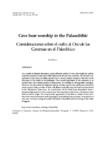Mostrar o rexistro simple do ítem
Cave bear worship in the Palaeolithic
| dc.contributor.author | Wunn, I. | |
| dc.date.accessioned | 2010-01-25T09:38:53Z | |
| dc.date.available | 2010-01-25T09:38:53Z | |
| dc.date.issued | 2001 | |
| dc.identifier.citation | Cadernos do Laboratorio Xeolóxico de Laxe, 2001, 26: 457-463 ISSN: 00213-4497 | es_ES |
| dc.identifier.issn | 0213-4497 | |
| dc.identifier.uri | http://hdl.handle.net/2183/6536 | |
| dc.description.abstract | [Abstract] As a result of detailed discussion under different points of view, this study has neither endorsed evidence of any early belief system nor of cave bear worship. All relevant conceptions of that kind are either products of a certain mental climate at the time of the discovery of the fossils or of ideologies. The current hypothesis of the existence of an ancient bear cult is based partly on discoveries, but mainly on ethnographic analogies. However, the discussion of religious customs among recent hunter-gatherers proves that what remains of the practise of their cult differs markedly from the fossil remains found in the Mousterian bear-caves. An examination of the fossil bone formations from a palaeontological point of view makes clear that supposed ancient bear cult sites are bone beds of natural origin. The characteristic appearance of the sites is a result of the activities of the bears themselves and of geological and sedimentary processes. Conceptions of cave bear worship during the early and middle Palaeolithic period belong to the realm of legend | |
| dc.language.iso | eng | es_ES |
| dc.publisher | Universidade da Coruña | es_ES |
| dc.subject | Cave bears | es_ES |
| dc.subject | Worship | es_ES |
| dc.subject | Palaeolithic | es_ES |
| dc.title | Cave bear worship in the Palaeolithic | es_ES |
| dc.title.alternative | Consideraciones sobre el culto al Oso de las Cavernas en el Paleolítico | |
| dc.type | info:eu-repo/semantics/article | es_ES |
| dc.rights.access | info:eu-repo/semantics/openAccess |






